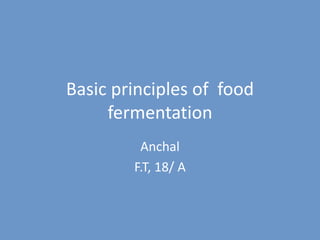
Basic principles of food fermentation
- 1. Basic principles of food fermentation Anchal F.T, 18/ A
- 2. Fermentation It refers to a metabolic process in which organic compounds ( particularly carbohydrates ) are broken down to release energy without the involvement of a terminal electron acceptor such as oxygen . or It is the term used by the microbiologists to describe any process for the production of a product by means of the mass culture of a microorganisms.
- 3. Products can either be : 1. The cell itself : refered to as biomass production e.g spirullina 2. Microorganism own metabolite : refered to as product from a natural or genetically improved strains e.g. Amino acids, lipids, carbohydrates, vitamins, co-enzymes, antibacterial agents, antifungaletc 3. Microorganism foreign product : refered to as product from recombinant DNA technology on genetically engineered strain that is recombinat strain e.g. Human therapeutics, Enzymes, Amino acids. (Brian Pumphrey New Brunswick Scientific (UK) Ltd and Christian Julien New Brunswick Scientific Benelux BV,The Netherlands)
- 4. APPLICATIONS OF FERMENTATION 1. In the production of organic solvents such as citric and lactic acids 2. Production of foods and food products such as ogi, fufu, gari e.t.c 3. Production of condiments such as iru 4. Production of dairy products such as yoghurt, butter milk, sour cream 5. In processing of meat and fish to refined products like sausages, cured harms, fish sauce 6. In production of beverages and related products such as beer, ale, vinegar, palmwine e.t.c 7. In pharmaceutical industries for producing compound such as antibiotics and vaccines in food supplement production such as production of single cell protein, amino acids,vitamins 8. In production of organic solvents e.g acetone, butanol ethanol e.t.c
- 5. The main advantages of fermentation as a method of food processing are: 1. The use of mild conditions of pH and temperature which maintain (and often improve) the nutritional properties and sensory characteristics of the food. 2. The production of foods which have flavours or textures that cannot be achieved by other methods 3. Low energy consumption due to the mild operating conditions 4. Relatively low capital and operating costs 5. Relatively simple technologies.
- 6. The component parts of a fermentation process 1. Microorganism 2. Bioreactors 3. Type of fermentation process 4. Consideration of factors that control the growth of m.o. in food fermentation. 5. Sterilization of medium, fermenters/bioreactors and ancillary equipments. 6. Growth of organism in the production fermenter. 7. Extraction and purification of the product. 8. Disposals of effluents produced by the process. ( principals of fermentation technology, P.F. Stanbury et.al.,)
- 7. Knowledge of nutritional requirements Knowledge of environmental requirements (incubation temp, O2 requirement) M/Os must be removed from natural environments and cultured in lab. Separation techniques required Isolation of pure culture of one type of M/O M/O of interest must be separated from all other bacteria in the environmental sample. All media, lab supplies must be sterile. Once a pure culture is achieved, no contaminating M/O can be introduced. Aseptic techniques Techniques for storage of pure cultures Techniques are needed that facilitate working with pure cultures. Microorganisms
- 8. Isolation Techniques Isolation of Discrete Colonies from a Mixed Culture Spread Plate Method Streak Plate Method Pour Plate Technique Isolation of Pure Cultures from a Spread Plate/Streak Plate Preparation Aseptic Transfer Techniques
- 10. Fermentation Types Solid state fermentations Microbes grow on a moist solid with little or no free water (capillary water might be present) Eg: Mushroom cultivation, bread making, processing of cocoa, manufacture of traditional foods – miso, soy sauce, tempeh Aerobic Process - Koji fermentation Anaerobic process - Production of fermented meat products Submerged cultures May use a dissolved substrate or a solid substrate suspended in a large amount of water to form a slurry Eg: Pickling vegetables, producing yoghurt, brewing beer, producing wine and soy sauce Aerobic Process - Citric acid production by Aspergillus niger Anaerobic Process - Yoghurt production
- 11. Submerged culture fermenters • Stirred tank fermenter • Bubble column • Airlift fermenter • Fluidized bed fermenter • Trickle-bed fermenter • Tray fermenter • Static bed fermenter • Tunnel fermenter • Rotary disc fermenter • Rotary drum fermenter • Agitated tank fermenter • Continuous screw fermenter Solid state fermenters
- 12. Batch It is a technique for large scale production of microbes or microbial products in which, at a given time , the fermenter stopped and the culture is worked up. Fed-batch In this , the fresh aliquot of the medium is continously or periodically added, without the removal of the culture fluid. Continous It is continous culture or processing in which the growth of the organism is controlled by the availability of growth limiting chemical components of the medium. Types of culture systems
- 14. Types of Fermentation Alcoholic •Ethanol + CO2 •Saccharomyces cerevisiae •Eg: Beer Lactic acid •Homolactic: •Lactic acid •Lactobacillus/ Streptococcus •Eg: Yogurt •Heterolactic: •Lactic acid + ethanol + CO2 •Leuconostoc •Eg: Kimchi Propionic acid •Propionic acid + acetic acid + CO2 •Propionibacteri um •Eg: Swiss cheese Butyric acid •Butyric acid, acetic acid, butanol, isopropanol, acetone, ethanol + CO2, H2 •Clostridium butyricum Formic acid •Mixed acid: •Lactic acid + acetic acid + succinic acid + ethanol + formic acid (gives CO2 •Escherichia •Butanediol: •2,3- butanediol, lactic acid, acetic acid, ethanol, formic acid (gives CO2 + H2) •Klebsiella Acetic acid • Acetic acid, gluconic acid, kojic acid • Acetobacter
- 15. Factors that control the growth of m.o. in food fermentation Intrinsic factors • Nutrient content • Substrate pH • Antimicrobials • Redox potential • Water activity Extrinsic factors • Storage temperature • RH of environment • Presence of other m.o.
- 16. References • http://lecturenotesfree.blogspot.in/2013/03/f ermentation.html • principals of fermentation technology, P.F. Stanbury et.al., • FOOD PROCESSING TECHNOLOGY Principles and Practice Second Edition, P. Fellows • https://www.researchgate.net/publication/22 5946883